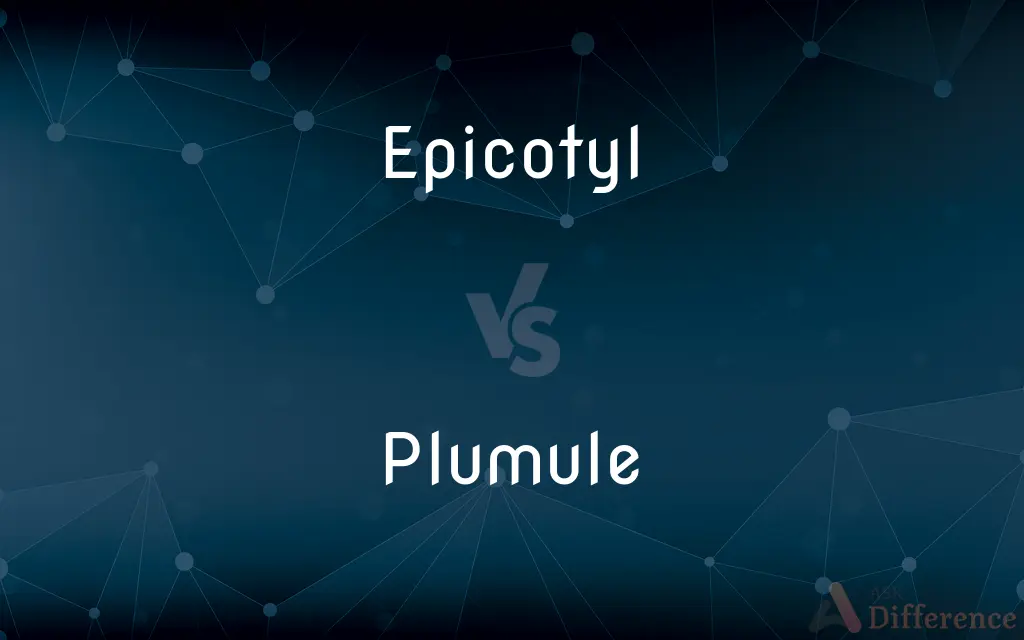Epicotyl vs. Plumule — What's the Difference?
By Tayyaba Rehman & Maham Liaqat — Updated on March 20, 2024
Epicotyl is the stem-like part above the cotyledons in seedlings, whereas plumule is the embryonic shoot within the seed.

Difference Between Epicotyl and Plumule
Table of Contents
ADVERTISEMENT
Key Differences
Epicotyl refers to the portion of a seedling found above the cotyledons, acting primarily as a stem-like structure during early plant development. It elongates and lifts the developing leaves and plumule towards the light. On the other hand, the plumule is the embryonic shoot contained within the seed that, upon germination, develops into the first true leaves of a plant. It is protected by the cotyledons in dicots or by the coleoptile in monocots.
The epicotyl plays a crucial role in the initial stages of a plant's life, facilitating the process of photomorphogenesis, which is the growth and development influenced by light. It helps the seedling emerge from the soil and positions the plumule in an optimal location for light absorption. Whereas, the plumule contains the precursor tissues for future plant growth, including leaves and possibly shoot meristems, essential for subsequent vegetative development.
In terms of physical appearance, the epicotyl can often be seen as a small, green, stem-like structure, especially noticeable in dicot seedlings, where it is prominent and elongates quickly after germination. In contrast, the plumule, being the embryonic shoot, is usually less visible until it has emerged and expanded into true leaves.
The epicotyl's growth is influenced by various external factors, including light, temperature, and humidity, which can affect its length, orientation, and overall development. The plumule's development, while initially dependent on the protective environment provided by the epicotyl and cotyledons, eventually takes over as the primary photosynthetic organ of the young plant.
In summary, while both epicotyl and plumule are critical to the germination and early growth stages of plants, they serve distinct functions. The epicotyl acts as a support structure, guiding and protecting the young shoot, whereas the plumule is the initial shoot system itself, destined to develop into the plant's first true leaves and subsequent shoots.
ADVERTISEMENT
Comparison Chart
Definition
Part of seedling above the cotyledons, acting as a stem.
Embryonic shoot inside the seed, developing into leaves.
Function
Facilitates photomorphogenesis and emergence from soil.
Develops into the plant's first true leaves.
Appearance
Visible as a green, stem-like structure post-germination.
Less visible until it emerges as true leaves.
Influence Factors
Light, temperature, humidity affect its development.
Initially dependent on epicotyl and cotyledons for growth.
Role in Germination
Supports and positions the plumule for light absorption.
Central to the vegetative development of the plant.
Compare with Definitions
Epicotyl
Part of seedling visible post-germination.
After germination, the epicotyl became noticeable above the soil surface.
Plumule
Embryonic shoot within the seed.
The plumule began to develop as the seed germinated.
Epicotyl
Supports initial growth.
The epicotyl lifted the young leaves towards the sunlight.
Plumule
Develops into plant's true leaves.
The plumule unfolded into the seedling's first set of true leaves.
Epicotyl
Influenced by external factors.
The length of the epicotyl was affected by the available light.
Plumule
Central to vegetative growth.
The plumule's expansion marked the beginning of the plant's vegetative phase.
Epicotyl
Aids in plant's emergence.
The sturdy epicotyl helped the plant break through the soil layer.
Plumule
Initially less visible than epicotyl.
Hidden within the seed, the plumule was initially hard to discern.
Epicotyl
Stem-like structure above cotyledons.
The epicotyl extended upwards as the seedling emerged from the soil.
Plumule
Protected by cotyledons.
Nestled between the cotyledons, the plumule was safe from damage.
Epicotyl
An epicotyl is important for the beginning stages of a plant's life. It is the region of a seedling stem above the stalks of the seed leaves of an embryo plant.
Plumule
A down feather.
Epicotyl
The stem of a seedling or embryo located between the cotyledons and the first true leaves.
Plumule
The young shoot of a plant embryo above the cotyledons, consisting of the epicotyl and often of immature leaves.
Epicotyl
(botany) In plants with seeds, that portion of the embryo or seedling above the cotyledons.
Plumule
(botany) The first bud, or growing point, of a plant embryo, situated above the cotyledons.
Plumule
(zoology) A down feather.
Plumule
(zoology) The aftershaft of a feather.
Plumule
(zoology) One of the featherlike scales of certain male butterflies.
Plumule
The first bud, or gemmule, of a young plant; the bud, or growing point, of the embryo, above the cotyledons. See Illust. of Radicle.
Plumule
A down feather.
Common Curiosities
What is a plumule?
The plumule is the embryonic shoot within the seed that develops into the first true leaves of the plant upon germination.
How do the epicotyl and plumule differ in function?
The epicotyl acts as a support, facilitating the seedling's emergence from the soil and positioning the plumule for light absorption, while the plumule develops into the plant's first true leaves.
Can the epicotyl be seen in all types of plants?
The epicotyl is especially noticeable in dicot seedlings, where it is prominent and elongates quickly after germination.
How does the environment affect the epicotyl?
The growth of the epicotyl is influenced by light, temperature, and humidity, which can affect its length, orientation, and overall development.
What role does the epicotyl play in photomorphogenesis?
The epicotyl facilitates photomorphogenesis by guiding and protecting the young shoot, allowing the seedling to emerge from the soil and absorb light efficiently.
How does the plumule contribute to the plant's growth?
The plumule contains precursor tissues for future plant growth, including leaves and possibly shoot meristems, essential for vegetative development.
Is the plumule visible immediately after germination?
The plumule is usually less visible until it has emerged and expanded into true leaves.
Are epicotyl and plumule present in both dicots and monocots?
Both epicotyl and plumule are present in dicots, while in monocots, similar structures may be referred to differently, such as the coleoptile protecting the young shoot.
What is an epicotyl?
The epicotyl is the part of a seedling that is found above the cotyledons, functioning as a stem-like structure during the early stages of plant development.
What protects the plumule during germination?
The plumule is protected by the cotyledons in dicots or by the coleoptile in monocots during germination.
How do the epicotyl and plumule interact during germination?
During germination, the epicotyl lifts and positions the plumule above the soil, allowing it to unfold into true leaves and begin photosynthesis.
Can the length of the epicotyl vary among plants?
Yes, the length of the epicotyl can vary depending on the species of the plant and environmental conditions such as light availability.
How do cotyledons relate to the epicotyl and plumule?
Cotyledons are seed leaves that provide nutrients to the growing seedling and protect the plumule, while the epicotyl emerges from between the cotyledons to support the seedling's growth.
What happens to the epicotyl and plumule as the plant matures?
As the plant matures, the epicotyl may become part of the stem, while the plumule develops into the first true leaves and continues contributing to the plant's vegetative growth.
Share Your Discovery

Previous Comparison
Effort vs. Effet
Next Comparison
Harp vs. LyreAuthor Spotlight
Written by
Tayyaba RehmanTayyaba Rehman is a distinguished writer, currently serving as a primary contributor to askdifference.com. As a researcher in semantics and etymology, Tayyaba's passion for the complexity of languages and their distinctions has found a perfect home on the platform. Tayyaba delves into the intricacies of language, distinguishing between commonly confused words and phrases, thereby providing clarity for readers worldwide.
Co-written by
Maham Liaqat














































